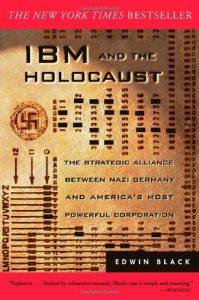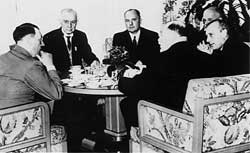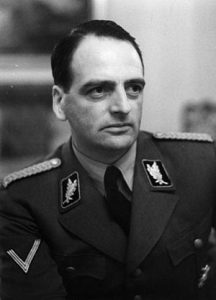Some observations about IBM and the Holocaust
By Hadding Scott
Copyright Jan27.org 2018

Recently I noticed that the general claims espoused by Edwin Black in his books of anti-German hate-propaganda are treated as foundations for kosher-conservative arguments by people like Alex Jones and Dinesh D’Souza. I even saw Edwin Black appearing as a guest on Infowars. Most of the people who take Black’s claims as authoritative, I suspect, have not actually read his books and evaluated his arguments. Here I make some observations about his book IBM and the Holocaust, beginning with a very brief account of the general history of IBM in relation to National-Socialist Germany, as gleaned from this 500-page book.
Herman Hollerith was a son of German immigrants who, as an employee of the United States Census Bureau, invented a machine that would allow the census to be completed much faster and less expensively using cards with holes punched in them. He founded the Tabulating Machine Company, which leased out its machines for census-taking.
Thomas J. Watson was a man who at one time had intended to become a schoolteacher, but as an employee of National Cash Register in the late 19th and early 20th centuries learned cutthroat monopolistic business practices. Although ruthless in competition, Watson was generous toward his employees and seemed in other respects the epitome of bourgeois respectability. He was the chairman of the American section of the International Chamber of Commerce and of the Carnegie Endowment for World Peace, and a trustee of New York University.
It was under the leadership of Thomas J. Watson that the name of the company founded by Hermann Hollerith was changed to International Business Machines.
Deutsche Hollerith Maschinen Gesellschaft, called Dehomag for short, was a German company founded in 1910 by Willy Heidinger, who had licensed all of Hollerith’s patents.
In 1922, at a time of economic distress, 90% of Dehomag’s stock was acquired by IBM, so that, although formally still a German company operating under license from IBM, IBM effectively owned Dehomag. Just 10% of Dehomag’s stock was left in the hands of Willy Heidinger, but even these shares carried restrictions: they could not be sold except to IBM. Since Heidinger and other executives of Dehomag continued to cherish the idea that they were an independent, German enterprise in which IBM had invested, rather than a mere subsidiary that should simply obey orders issuing from Endicott, New York, the relationship between Dehomag and IBM was often stormy.

Although IBM established subsidiaries in various other European countries — Watson Italiana, Svenska Watson, etc. — Dehomag represented IBM’s greatest source of profit outside of the United States even before Adolf Hitler came to power. Thereupon, the various projects of social and economic management undertaken by Hitler’s government multiplied the applications for Hollerith technology in Germany.
The National-Socialist period, however, also created many problems for IBM in attempting both to control and to profit from Dehomag. There were barriers to transferring funds out of Germany, and there was a strong incentive to avoid any appearance that Dehomag was foreign-controlled.

As an advocate for peace and fair treatment of Germany, in 1937 Thomas Watson accepted a medal from the German government, its highest award that could be given to a foreigner. On 6 June 1940, however, as France was collapsing under German attack (France having declared war on Germany), Watson announced that he was returning the medal.
This made Watson’s relations with Dehomag even more difficult, since any association with his name was now a liability in Germany. There was now an effort to find an alternative to the German government’s reliance on IBM’s technology, and there were potential alternatives, but it would have taken several years to implement them, and in the midst of a war this was not practical.
Edwin Black kvetches that Watson should have sold IBM’s shares and washed IBM’s hands of Dehomag at this point (as Dehomag’s managers and the German authorities preferred he do), but it is hard to see what this is supposed to have accomplished in regard to “the Holocaust” since Hollerith cards as well as Hollerith machines were now being produced in Europe.
From the time in 1941 when the U.S. Government began to put restrictions on transactions and communications with Germany and Axis Europe, Watson seems to have conformed rigorously with those regulations (despite Edwin Black’s mutterings to the contrary). Two officials of IBM’s Swiss and Swedish subsidiaries ignored those restrictions and Watson’s own instructions in the matter, as an internal investigation by IBM later discovered. Edwin Black insinuates that Watson wanted those employees to disobey his instructions but offers nothing beyond his own bias against Watson as an argument.
Edwin Black is upset because Dehomag was efficiently and profitably managed during the war by a trustee put in charge of it by the German government, and by the fact that IBM was able to collect its share of the profits from Dehomag after the war. (Some other multinational corporations, like Coca-Cola, had the same arrangement.) This is supposed somehow to make IBM guilty for the Holocaust.
Although the title of Edwin Black’s book is IBM and the Holocaust, it seems that Black would be in favor of having Jews file suits against IBM on any pretext whatsoever, even without the premise that IBM was an accessory to the Holocaust (an alleged project of killing all the Jews in the world, which Black says began in January 1942), just to punish the company for having temporarily, for a few years, refused to support the Jewish campaign to destroy National-Socialist Germany, which began in March 1933, long before the alleged Holocaust. Thomas J. Watson was a very bad man, according to Edwin Black, because he tried to prevent war.
* * *

The idea for Edwin Black’s book IBM and the Holocaust came from the fact that the United States Holocaust Memorial Museum had on display a machine for processing IBM cards. In the introduction he offers this summary of the book’s argument:
It tells the story of IBM’s conscious involvement – directly and through its subsidiaries – in the Holocaust, as well as its involvement in the Nazi war machine that murdered millions of others throughout Europe.
Since there was no Holocaust, Black is not really going to be able to demonstrate any involvement by IBM in that. What he does demonstrate is that IBM’s technology was used to keep track of Jews, to transport them efficiently by train, and to exploit their labor efficiently once they had arrived at a concentration camp. At worst, automated record-keeping was an aid in knowing what wealth each Jew possessed that could be expropriated.
Edwin Black does not seem to know what the Holocaust is supposed to have been anyway. He calls it “the murder of six million Jews and an equal number of other Europeans.” Already by the 1970s the alleged number of non-Jewish dead from the concentration camps had been pared down to a number less than the Jewish six million, and as of today the figure promulgated by no less an authority than Yehuda Bauer is less than one-half million.
Black also claims that Zyklon-B pellets at Auschwitz were “dropped into water buckets to accomplish the mass asphyxiation.” Where did he get that?
* * *
Edwin Black tells an extraordinary story about his own family that shows his personal stake in exploring the question about IBM’s involvement in the Holocaust:
My parents are Holocaust survivors, uprooted from their homes in Poland. My mother escaped from a boxcar en route to Treblinka, was shot, and then buried in a shallow mass grave. My father had already run away from a guarded line of Jews and discovered her leg protruding from the snow. […]
The Nazis had my parents’ names. How?
How negligent of those guards to let Papa Black just run away from the line of Jews that they were guarding! And how convenient that he then happened to find his future wife’s leg protruding from the snow after she had been shot and buried in a mass grave! A sloppy burial, that was.
Aside from the unlikelihood of Edwin Black’s story about his parents, the fact that “the Nazis” were able to locate Edwin Black’s parents and identify them as Jews – in Poland – probably did not depend much on IBM’s record-keeping technology because, as Black admits elsewhere in the book, the Jews of Poland were generally easy to identify:
Unlike German, Austrian, and Czech Jewry, most of Polish Jewry was not assimilated. Intensely religious and not infrequently cloistered into very separate communities, they were often discernible by certain physical features that Eastern Europeans associated with Jews. Characteristic dark beards and other facial attributes made their appearance very different from many Poles. Openly speaking Yiddish and Germanic dialects only set them further apart…. In short, one didn’t need a punch card-driven census to identify most of Polish Jewry.
* * *

According to Edwin Black, it was obvious from the moment when Hitler came to power in 1933, that it was on the agenda “to identify and destroy Germany’s 600,000-member Jewish community.”
Der Fuhrer [sic] wanted an Aryan Germany to dominate all of Europe with a master race subjugating all non-Aryans. For Jews, Hitler had a special plan: total destruction. There were no secrets in Hitler’s vision. He broadcast them loudly to the world. They exploded as front-page headlines in every major city, on every radio network, and in weekly cinema newsreels. (23)
Elsewhere Black claims:
When Hitler came to power, in January 1933, he made an open promise to create a Master Race, dominate Europe, and decimate European Jewry.”
This is utterly false! The National-Socialists did not even use the term Master Race (Herrenrasse). The claim that the Germans used this term was a relic of anti-German propaganda from the First World War. There was never a declared intention to kill all the Jews; the closest approximation is Hitler’s threat, not in January 1933 but in January 1939, that if international finance-Jewry dragged Germany into another war it would lead to the Vernichtung (a very vague word) of the Jewish race in Europe. As for dominating Europe, it is natural for Germany to “dominate” Europe, because Germany is an economic colossus. If the meaning is that Hitler had always said that he wanted war, we may note that in January 1939 he indicated that he would go to war only if compelled.
These statements are attributed to Hitler by Black so that he can hold Thomas J. Watson accountable for collaborating with a government that held such positions. This, in turn, sets up IBM to be sued by Jews.
* * *
To maximize IBM’s culpability for the putative Holocaust, Edwin Black asserts that a census identifying all the Jews in Germany could only be done with the aid of automated accounting of the kind that IBM made available. That is a useful assertion for putting the maximum possible blame on IBM, but on the whole it is clearly false. Most Jews were not difficult to identify.
Statistician Karl Keller wrote for an academic publication in 1934:
The determination of Jewish descent will not be difficult because membership in the Jewish faith and membership in the Jewish culture were nearly identical before the emancipation of the Jews. It is therefore sufficient to check the change of denominations in church registers and registry offices for the last 130 years. (K. Keller, Allgemeines Statistisches Archiv, 1934)
One can imagine though, that automated file-keeping was an extraordinarily useful innovation for police, so that for a Jew trying to blend in with the non-Jewish population, fooling the authorities about who he was would be very difficult once he came under scrutiny. The crypto-Jew tells his cover story, and the police check the records, which they can do very quickly now, and they find out that he is hiding something. There was also the IBM Fingerprint Selecting Sorter. But it is quite a leap from the fact that the German government was able to identify people, to the conclusion that Jews thus identified would be killed.
Black calls attention to the fact that persons of only slight Jewish ancestry were detected and documented, but this has no relevance for “the Holocaust,” since persons with only one or two Jewish grandparents were generally not counted as Jews, and, as Mischlingen, were allowed to stay in Germany and even to serve in the armed forces (although a special dispensation was required for them to become officers). The total absence of any documentable Jewish ancestry was required only for joining the SS.
* * *
Indirectly, Edwin Black admits that the Hollerith cards used in concentration camps had no way to record death by gas. He says that murdered prisoners were recorded as having died by “natural causes.” Elsewhere he says that the disappearance of murdered prisoners was recorded as “special treatment.” In addition to these two alleged euphemisms, it was also possible to record that a prisoner had departed through execution. It cannot have been the policy of the SS to have deliberate killings of prisoners recorded as deaths by natural causes, because how, then, could deaths by natural causes – of which there were many – be recorded? As for special treatment, the statistician Richard Korherr was adamant as late as the 1970s that this did not mean killing. It is common to hear champions of Holocaustology claim that gassings of millions of Jews are known because the Germans kept very good records, but there is no German record of that. This is “evidence” created through imaginative interpretation.
Black refers to “the automation of human destruction” but he demonstrates no such thing. Automated record-keeping and sorting, yes, but what was done with the records is a completely other question. In fact, the records were only of value for as long as the person characterized in the record remained alive. If Jews had been killed in short order near the cities that they inhabited, instead of being loaded onto trains and sent to camps to work, there would have been no need to create a record of details, including work skills, of each individual Jew.
The agency that used IBM technology to keep track of Jews and other inmates in concentration camps was called the Arbeitsdienst – the Labor Service. Therefore, in order to implicate Hollerith machines in the Holocaust, Black speaks little of gas-chambers and more of “extermination through labor,” a concept that he attributes to Oswald Pohl. It does not seem to occur to Black that National-Socialist Germany recorded the work-skills of its prisoners and assigned them to jobs because there was an acute shortage of manpower and that the labor was needed. In that light, killing the prisoners cannot have been the purpose of labor-assignments.
Hollerith machines, after all, had been used for the same kind of purpose outside of the concentration camps. Yet Edwin Black insists that there was something sinister about the use of Hollerith machines by the “Labor Service” in the concentration camps.
* * *
Black asserts:
Dehomag’s top management was composed of openly rabid Nazis who were arrested after the war for their Party affiliation.
This is false. Willy Heidinger died during the war. Karl Hummel resumed his position on the Board of Directors of Dehomag after the war. Only General Manager Hermann Rottke was “arrested” – but by the Red Army – and he died in Soviet custody. Edwin Black says that Rottke’s wife had been an ardent National-Socialist, but does not say that about Rottke. Black has misled his readers by implying that all the management was “arrested” and by suppressing the fact that Rottke’s jailer was the Soviet government, a fact that tends to negate any presumption of justice.
What did happen is that during the war the German government placed Dehomag and all the other subsidiaries of IBM under the direction of a fiduciary named Hermann Fellinger, who operated the enterprises as if they were his own, maximizing profits to the extent that he could. This practice of the Germans in dealing with enemy-owned companies during wartime (a repetition of how such matters had been handled during the First World War) was fortunate for Thomas J. Watson and IBM, but it in no way demonstrates that Watson remained in control the whole time, which is an inference that Black very much wants to make – obviously as a necessary premise for Jewish lawsuits against IBM. After rendering such conscientious service, and after cooperating fully with the victorious Allies, Fellinger was arrested for some reason that Edwin Black does not state.
* * *

Dr. Edmund Veesenmayer was the right-hand man of Adolf Hitler’s personal economic advisor, Wilhelm Keppler. He is relevant to the story of IBM and Dehomag for two reasons.
First, because in December 1940 he advised Watson’s representative Chauncy on the question of whether IBM would have to give up its majority shareholding in Dehomag. Veesenmayer’s response was that it was “advisable” to give up the majority but that the government would not force IBM to do this.
Second, because Veesenmayer sat on a wartime advisory committee created by the German government to keep Dehomag’s activities in line with Germany’s needs.
Because of this association with Dehomag, and ultimately therefore with IBM, Edwin Black wishes to blacken Veesenmayer’s reputation and thereby to inflict guilt by association.
Veesenmayer at one time was Germany’s liaison to the Croatian Ustashi leader Ante Pavelich. The alleged behavior of the Ustasha becomes Veesenmayer’s fault. But look at what kind of caricature Edwin Black presents:
Ustashi militias were allowed free rein under Veesenmayer’s eye…. In the annals of wartime savagery against the Jews, there was no group as sadistic as the Croatian Ustashi. Using chainsaws, axes, knives, and rocks, frenzied Swastika-bedecked Ustashi brutally murdered thousands of Jews at a time. Ustashi leaders openly paraded about Zagreb with necklaces comprised of Jewish tongues and eyeballs cut and gouged from women and children…. Pavelich himself was fond of offering wicker baskets of Jewish eyeballs as gifts to his diplomatic visitors.
Obviously a basket of Jewish eyeballs is a gift that would make a wonderful impression on any guest!
Most of the sources that Black cites for such details were published during the war. Edwin Black for whatever reason seems to lack the common sense to recognize that his sources and the stories in them are not credible. Also, Black seems to be unaware that the Ustasha had their own emblem, a checkerboard, so that they would not have been wearing a swastika.
Another important story used to attack Veesenmayer and Dehomag is about transporting Jews out of Hungary.
In spring 1944, after a stint at der Fuhrer’s headquarters, Veesenmayer would be sent East again, this time as Minister to Hungary. His instructions were to form a new puppet government in Budapest and organize the Hungarian railroads.
Veesenmayer was for the first time completely in charge of German operations in a puppet nation. In Budapest, he formed a close alliance with Eichmann and together they orchestrated the systematic destruction of Hungarian Jewry.
Admiral Horthy had been interfering with deportations of Jews. Black suggests that the Hungarians were reluctant and Veesenmayer should have been reluctant to do anything to the Jews at this point because the Red Army was approaching and punishment for misdeeds was therefore imminent. This is a complete misinterpretation. It was precisely because the Red Army was approaching that the Jews were being rounded up and interned, not in some mad last-minute rush to kill all the Jews, but for the very practical purpose of making sure that Jews would not become active as guerrillas and saboteurs assisting the Red Army.
The fact that the purpose was not to send Jews to a special killing place but to get them away from the battlefront is evident in the fact that many of the Jews from Hungary were not sent to any alleged death-camp but westward to Austria – simply away from the front.
On 20 October 1944 there was a mass-deportation of Jews from Budapest. Black explains:
There weren’t enough freight cars. So within days, the 27,000 assembled Jews were sent on a death march to the Austrian border. Lines of marching Jews stretched out from Budapest, miles and miles long, girded by a parallel of corpses heaped along the road. Vesenmayer reported that 2,000 to 4,000 were being added daily. Many thousands died en route from the exhaustion, exposure, and starvation. They were in fact marched to death.
During the war years, IBM supplied elaborate Hollerith systems to nearly all the railways of Nazi-dominated Europe. Knowing how many freight cars and locomotives to schedule on any given day in any given location, anywhere across the map of Europe, required the computation capabilities of Hollerith. Punch card systems identified the exact location of each freight car, how much cargo it could accept, and what schedule it could adhere to for maximum efficiency.
What a strange juxtaposition of facts! The “death march” of Jews from Budapest to the Austrian border is necessitated by the fact that there are not enough freight cars to carry them. It seems likely that the account of how many died on the march is greatly exaggerated, but if we accept that having to walk from Budapest to Austria was a misfortune for the Jews that had to do it, we can say that under the circumstances — insofar as Hollerith technology tended to maximize the availability of trains and therefore minimize the occasions when the Jews would have to endure a “death march” – the Hollerith machine as employed by railroads was a source of great benefit to Jews during the war.
But, of course, if the inavailability of a train was due to the destruction wrought by Allied bombing, there was nothing that a Hollerith machine could do to fix that.
In Holocaust narratives, the sinister connotation given to trains, and now to the punch-card technology employed to operate railroads efficiently, is quite ironic given that the alternative was a so-called death march. One is reminded of the various hygienic measures (showers, removal of hair, use of Zyklon-B to kill insects) that the Germans employed to prevent the spread of disease among their prisoners, regarded with the very same Jewish paranoia.
* * *
The above is only a partial catalog of the problems with Edwin Black’s IBM and the Holocaust. It is truly a ridiculous book.
After the first edition, Black added a chapter to respond to the criticisms that the book received when it first appeared. He talks about the “several dozen” great Jewish authorities who assisted with making sure that the book was correct in its details.
Throughout the actual writing in 2000, some thirty-five world-class Holocaust historians and other experts reviewed my work, chapter by chapter, as the text rolled off the word processor…. For example, Gerhard Hirschfeld, president of the International Committee for the History of the Second World War, took six months to finish his methodical review. Scores of marginal notations were made, and many consultations ensued. Virtually all suggestions and corrections were adopted. Then the revised text was resubmitted over and over again until approved by each reviewer. Thus, IBM and the Holocaust became an extraordinary collaborating effort of international Holocaust and technology expertise.
He says that about half of those that he asked to check his work refused to participate. For all those alleged scholars who did participate in creating this book, however, it is much more of an indictment against them than against IBM.

